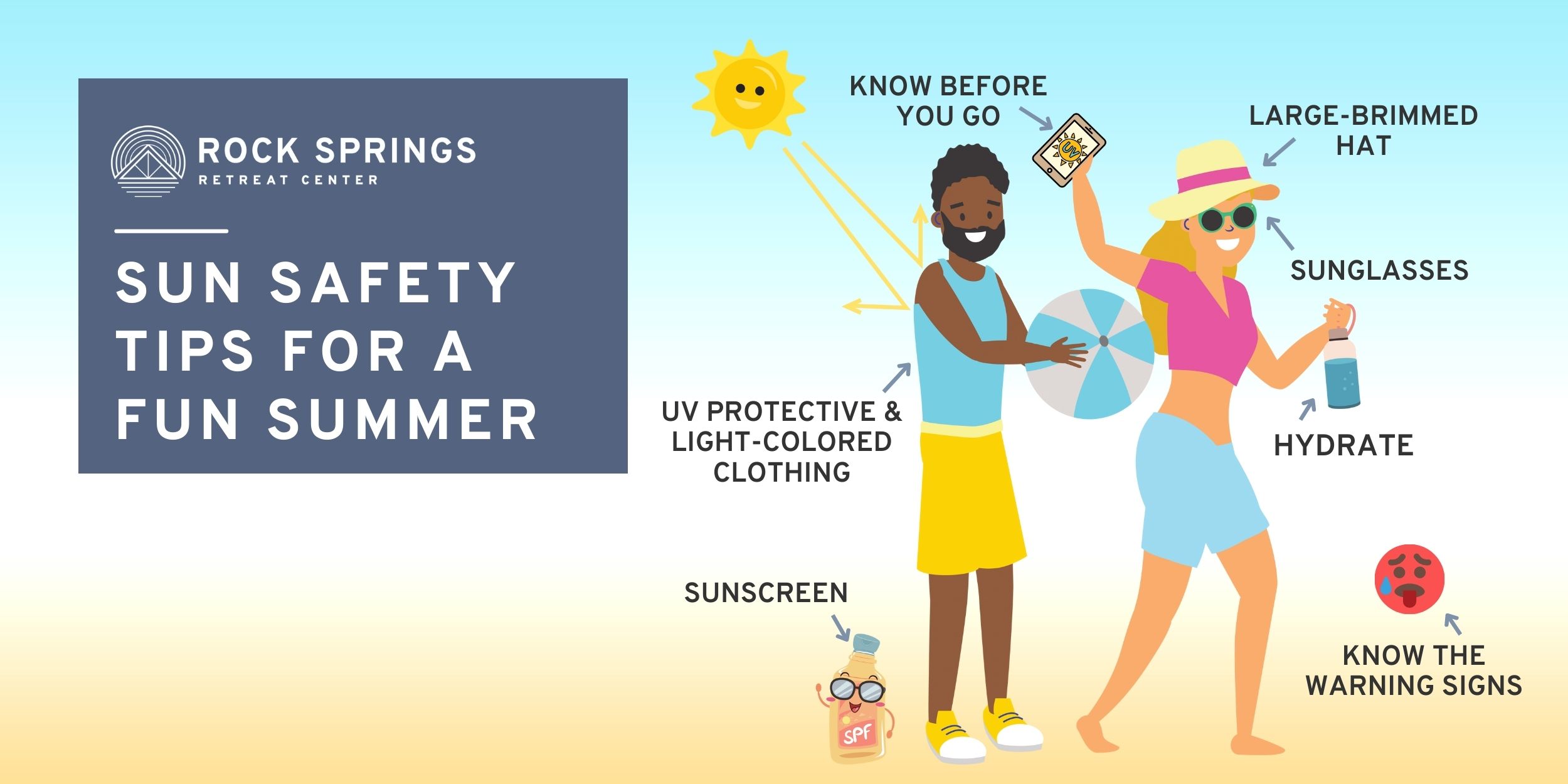
Rock Springs Retreat Center / June 30, 2022 /
Anna Rutherford /
0
Summer is here and you know what that means. A plethora of outdoor activities are calling your name to enjoy with your friends and family out in the sun! It’s the perfect time for an outdoor barbecue, go for a hike on your local trails, cool off with a refreshing dip in a spring, and hit up the pickleball court, all while soaking in some rays to make your skin shimmer with summer vibes. Being in the sun is what makes these activities so enjoyable, and we all look forward to beautiful, sunny days. While outdoor summer activities are loads of fun and encourage physical movement, it’s important to properly prepare yourself for the day ahead. Before you head out, be sure you follow these sun safety tips to ensure your summer is nothing but fun!
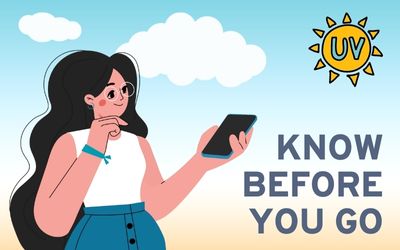
So, you’ve got your bags packed and you’re ready to head out to the beach! Well, slow down there, partner. We know you’ve waited all year for this moment, but there’s some housekeeping we need to do first. Regardless of what kind of activity you’re going to do, whether it’s the beach, cycling, or a game of basketball at the park, you need to go prepared. The sun can be unforgiving, and the last thing you want is your summer fun ruined because you forgot a couple of steps.
Days in the summer are longer, allowing for more time outdoors. That also means the sun is stronger, and the risk of heat-related illness is higher. Try to limit your time in the sun when its UV rays are at their strongest. A good resource for your area’s current UV forecast is NOAA. UV exposure levels are updated daily, and this can help you decide if the weather is safe enough for a long hike or intense play. If you’re able to, try to plan your activity in the morning or evening where the temperatures are cooler, and the sun isn’t as hard on your body compared to afternoons. It’s important to note that just because it’s forecasted to be cloudy doesn’t mean that you’re safe from the sun. UV rays can still penetrate through clouds.
Days in the summer are longer, allowing for more time outdoors. That also means the sun is stronger, and the risk of heat-related illness is higher. Try to limit your time in the sun when its UV rays are at their strongest. A good resource for your area’s current UV forecast is NOAA. UV exposure levels are updated daily, and this can help you decide if the weather is safe enough for a long hike or intense play. If you’re able to, try to plan your activity in the morning or evening where the temperatures are cooler, and the sun isn’t as hard on your body compared to afternoons. It’s important to note that just because it’s forecasted to be cloudy doesn’t mean that you’re safe from the sun. UV rays can still penetrate through clouds.
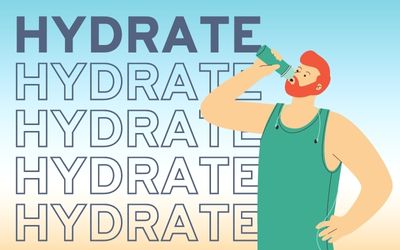
Hydrate, hydrate, hydrate. It’s absolutely essential. The sun’s rays raise your body’s temperature, thus triggering you to sweat to cool down, which causes your body to lose fluids and become dehydrated. Always have either a bottle of water on you or know where the closest water fountain is. Drink water constantly throughout the day, and if you’re engaging in a high level of activity, you may want to consider adding some electrolytes into your water to hydrate you quicker.
This goes without saying, but you’ll want to avoid any drinks that increase the effects of dehydration. That means caffeine, and yes, alcohol. However, we’re not trying to crush anyone’s summer relaxation dreams. If sipping on some daiquiris next to the pool is your thing, go for it. Just be smart about it. Stick to one drink per hour and drink plenty of water. Aim for 16 ounces of water for every 12 ounces of beer/4-6 ounces of liquor, minimum.
This goes without saying, but you’ll want to avoid any drinks that increase the effects of dehydration. That means caffeine, and yes, alcohol. However, we’re not trying to crush anyone’s summer relaxation dreams. If sipping on some daiquiris next to the pool is your thing, go for it. Just be smart about it. Stick to one drink per hour and drink plenty of water. Aim for 16 ounces of water for every 12 ounces of beer/4-6 ounces of liquor, minimum.
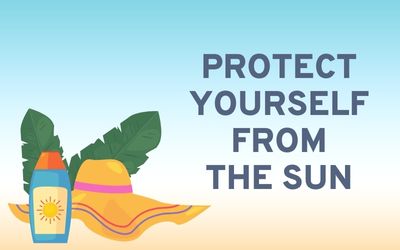
If you’re planning on being out in the sun for an extended period, it’s important that you dress appropriately to protect yourself. Hats, especially large-brimmed ones, help keep you cool and protect the skin on your scalp and face. Don’t forget sunglasses as well! Believe it or not, your eyes can get “sunburned” from prolonged UV ray exposure, which you can imagine is not a pleasant feeling. The color of your clothing also plays a big part. Choose clothing that is lighter in color, as those easily reflect sunlight while darker colors trap the heat from the sun. It can’t hurt to invest in some Ultraviolet Protective Factor (UPF) sun wear either. Much like sunscreen, UPF clothing helps block the amount of UV rays that pass through the fabric of your clothing.
Contrary to popular belief, you can still get sunburnt under shade. While being in the shade reduces UV ray exposure, it doesn’t completely block it out. This applies to trees, beach umbrellas, clouds, or anything that allows UV rays to pass through. And no, being underwater in the pool does not protect you. In fact, the clearer the water is, the easier it is for UV to penetrate the surface. Water, sand, concrete, and other light surfaces reflect UV rays, making UV the champion at finding your skin when playing a game of hide-and-seek. But you have a secret weapon. That’s right, sunscreen.
Contrary to popular belief, you can still get sunburnt under shade. While being in the shade reduces UV ray exposure, it doesn’t completely block it out. This applies to trees, beach umbrellas, clouds, or anything that allows UV rays to pass through. And no, being underwater in the pool does not protect you. In fact, the clearer the water is, the easier it is for UV to penetrate the surface. Water, sand, concrete, and other light surfaces reflect UV rays, making UV the champion at finding your skin when playing a game of hide-and-seek. But you have a secret weapon. That’s right, sunscreen.
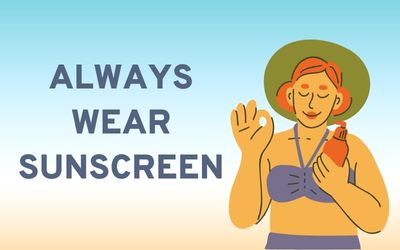
There’re countless types of sunscreens out there, many with different SPFs, in lotion and spray form, ones that are labeled specifically for tanning, and so on and so forth. We could write a dissertation on the science behind each of these products, but that’s not what we’re here for. So, let’s get down to the nitty-gritty on what sunscreen you need to keep your skin sun safe this summer.
Let’s start off by talking about sun protection factor (SPF). When shopping for sunscreen, it’s natural to go straight for the bottle that has the highest SPF. However, you may want to reconsider that the next time you shop. While the higher number does mean more protection, you’ll be shocked to find that the difference in protection between SPF 30 and SPF 100 is only 2%! So, which SPF should you choose then? That’s really up to you. Your best bet is to stick with SPF 30, at a minimum. If the higher SPFs put your mind at ease, go for it! There’re no negative consequences to using higher SPF sunscreens. Use the chart below that contains common SPFs found in sunscreen to help you decide on which SPF is right for you.
Let’s start off by talking about sun protection factor (SPF). When shopping for sunscreen, it’s natural to go straight for the bottle that has the highest SPF. However, you may want to reconsider that the next time you shop. While the higher number does mean more protection, you’ll be shocked to find that the difference in protection between SPF 30 and SPF 100 is only 2%! So, which SPF should you choose then? That’s really up to you. Your best bet is to stick with SPF 30, at a minimum. If the higher SPFs put your mind at ease, go for it! There’re no negative consequences to using higher SPF sunscreens. Use the chart below that contains common SPFs found in sunscreen to help you decide on which SPF is right for you.
Before you go grabbing that bottle of sunscreen off the shelf, double-check to make sure that it’s labeled with “broad spectrum” protection. This maximizes guarding your skin against both harmful UV rays - UVA which causes skin cancer and premature aging, and UVB which also causes skin cancer and sunburn. Sunscreens that don’t have broad-spectrum protection only protect your skin against UVB rays and while they are better than no sunscreen at all, your skin will thank you for the extra protection broad spectrum provides.
Apply your sunscreen everywhere that will be exposed to the sun 30 minutes prior to going out. Commonly missed areas are the entire face, scalp, hairline, behind the ears, the back of your hands, and yes, if the soles of your feet are exposed, there too! As silly as it may sound putting sunscreen on the bottom of your feet, it’s not a step you should overlook. Bob Marley passed away due to skin cancer on his foot.
Remember that sunscreen is not one and done. It needs to be reapplied throughout the day, so make sure you pack that bottle with you. Generally, you’ll want to put more sunscreen on every 2 hours, minimum. If you’re swimming or sweating, you’ll need to reapply sooner. If you have a water-resistant sunscreen (check your label), it’ll have directions on when you should reapply. If you wipe the sweat off your face or dry off with a towel, you also wipe off your sunscreen. So, don’t forget to put more on!
Apply your sunscreen everywhere that will be exposed to the sun 30 minutes prior to going out. Commonly missed areas are the entire face, scalp, hairline, behind the ears, the back of your hands, and yes, if the soles of your feet are exposed, there too! As silly as it may sound putting sunscreen on the bottom of your feet, it’s not a step you should overlook. Bob Marley passed away due to skin cancer on his foot.
Remember that sunscreen is not one and done. It needs to be reapplied throughout the day, so make sure you pack that bottle with you. Generally, you’ll want to put more sunscreen on every 2 hours, minimum. If you’re swimming or sweating, you’ll need to reapply sooner. If you have a water-resistant sunscreen (check your label), it’ll have directions on when you should reapply. If you wipe the sweat off your face or dry off with a towel, you also wipe off your sunscreen. So, don’t forget to put more on!

If you’re not used to being in or exerting yourself in a hot environment, your body needs time to adjust to the heat. Warm up your muscles with dynamic stretching and gradually ease yourself into the activity. Take frequent breaks. If there is shade nearby, rest there to cool off, reapply sunscreen, and hydrate, hydrate, hydrate. If you start to experience symptoms, don’t take these lightly. You could be suffering from a heat-related illness. While some heat-related illnesses fall on the mild side, there are also those on the extreme opposite end of the spectrum that can be life-threatening if left untreated. It’s important to act fast to alleviate any symptoms so you don’t tip the scale in the wrong direction. Below is a progressive scale of common heat-related illnesses and their symptoms. Familiarize yourself with the CDC’s proper actions to take if you or another are experiencing these symptoms. Knowledge is power.
Be mindful and pay attention to others who may be suffering from these symptoms without realizing it. If you find that your/someone else’s symptoms don’t improve or become worse, seek medical attention immediately.
Summer is truly a beautiful time of the year to get outdoors and have fun. Remember to always plan ahead before going out, dress appropriately, lather on the sunscreen, stay hydrated, and know the warning signs to look for when you or another are having heat-related symptoms. Now that you know how to safely have fun in the sun, why not check out our blog, 10 Ways to Burn Calories While Having Fun This Summer? We hope you found these sun safety tips to be helpful for your fun in the sun this summer with your friends and family. Leave your comments below on how you stay safe while in the sun and don’t forget to sign up for our newsletter for more health and wellness tips straight to your inbox!
